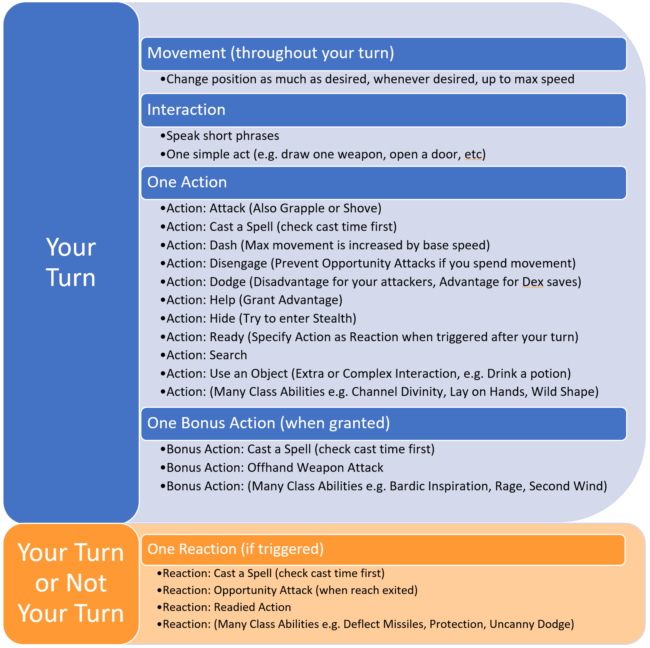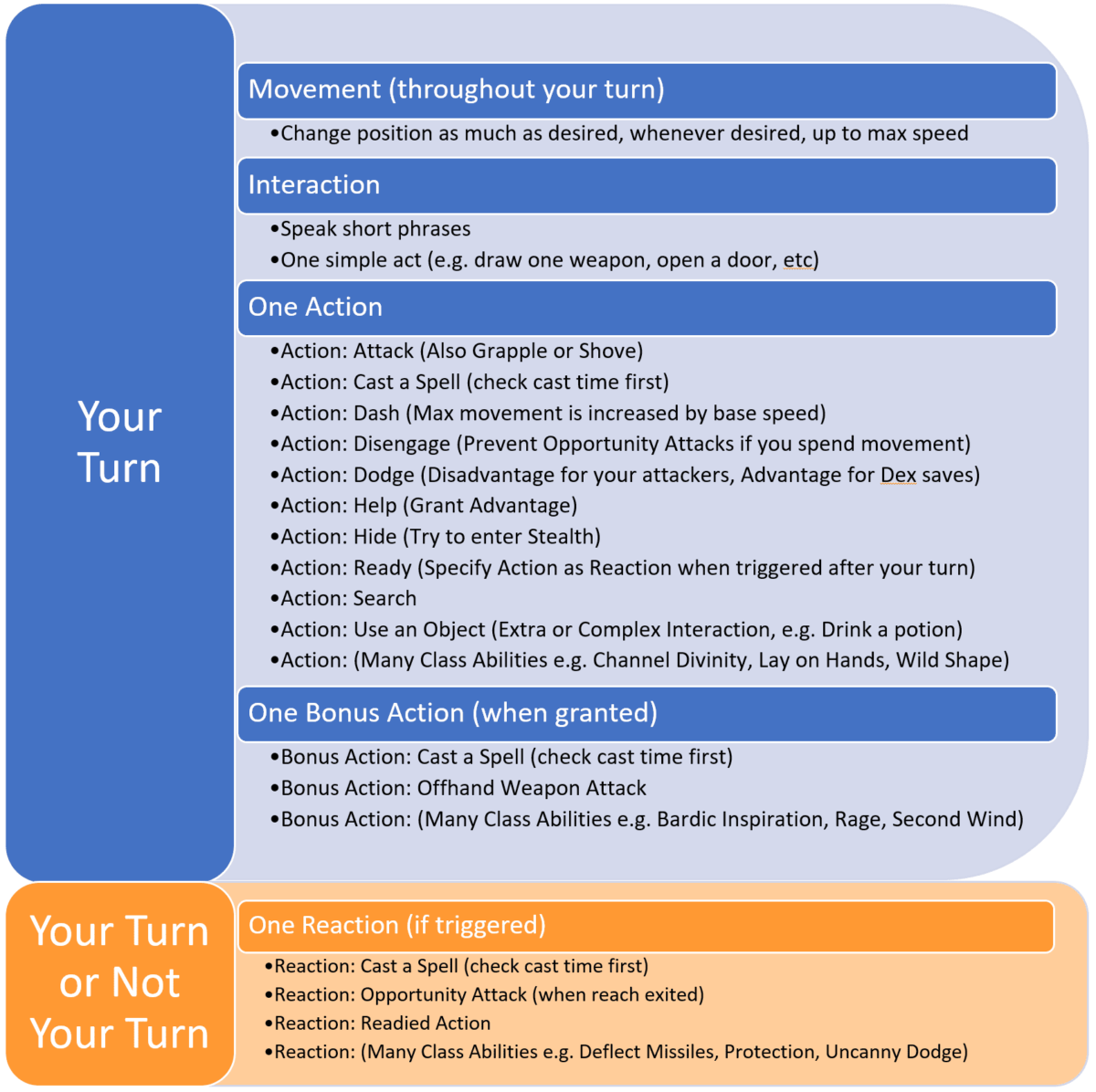 Part of an ongoing series of 5e (2014) Rules notes. This also covers 5.5e (2024) rules.
Part of an ongoing series of 5e (2014) Rules notes. This also covers 5.5e (2024) rules.
You will sometimes read about D&D and encounters and danger levels and rules imbalance and things like that, and you’ll hear the term “Action Economy.”
What’s that?
Essentially,
the larger your Action Economy ⇒
the more things you can do in a turn ⇒
the more powerful you are
And that’s true for individuals, as well as for groups.
- A big part of character advances are adding more attacks, more Bonus Action options, etc. Similarly, more powerful monsters have more attacks and actions in a turn (including legendary and lair powers).
- All things being equal, the side that has the greater numbers of combatants has an advantage in combat, because their cumulative Action Economy, the opportunities they have for success in combat, is greater.
- Bounded Accuracy , as one person put it, “makes everybody dangerous no matter how weak but does so at the cost of making everyone vulnerable no matter how strong.” Which means, by implication, over time a bunch of weak (but dangerous) characters can overwhelm a strong (but vulnerable) one.
- PCs often have advantage in combat because designed encounters often have more PCs vs fewer (but individually more powerful) enemies. Sure, that big monster there can do three physical attacks, or maybe a big spell effect. But the PCs together often get more Attacks, Spells, Bonus Action abilities, etc., than enemies, individually or (and this is important) in aggregate. They often also get specialized Reactions others than Opportunity Attack. This only starts to partially equalize when you get up to epic creatures that have legendary and lair actions, but even there, numbers tell.
- Everything you can do is part of your Action Economy: Actions, Bonus Actions, Reactions, and Moves. The more you can set yourself up (tactically, in a battle, or strategically, in your character design) to do something effective with all of those options in a turn, the more effective (and deadly) your character will be.

In short, the Action Economy is your range and quantity of actions in a round (see above), and implies the need, by extension, to maximize your effectiveness by using as much of that economy as possible.
How do GMs cope?
GMs bitch a lot about this: the boss fight that’s got the arch-critter-demon you’ve had the players trembling about for months … ending with the boss going down in two rounds as the 15 attacks the party can generate per turn (action economy!) overwhelms the 4-5 the boss can. Yeah, the boss is hitting for 80 damage, but four players hitting for 20 damage each (which is kind of low at higher levels) do just as much, and six players hitting for that do even more.
What (just to offer notes) do GMs/module writers do in the face of this?
- They add Minions! They’re not just color text — they help balance the “overwhelming numbers vs very powerful foe” equation by mitigating the former so that the latter can get some licks in. In general, the easiest way to make an encounter more difficult and dangers is not to make the BBEG more powerful, but add the number of minions and lieuts the players have to grind through (and defend against) to get to the boss.
- As mentioned, epic-level legendary creatures — dragons, liches, beholders, etc. — can get legendary and/or lair powers, which basically add to their Action Economy (and hurt like the dickens). GMs often add these non-canonically to other bosses, too.
- Do other things to add to a boss’s Action Economy. One suggestion I’ve seen that seems to have legs is making bosses, in a sense, multiple creatures (with different capabilities and HP pools and initiatives) presenting as a single creature.
- Split the Party. If the party can’t bring all of its power to bear — because it’s split up (by its own choosing or through an external force), or maybe because the attack vectors are limited (a narrow hallway, perhaps), its Action Economy is restrained.
The converse to all of these can be used (usually by the GM) to weaken a boss that seems too big to tackle.
Does this change in 5.5e?
 As a game design element, it doesn’t. The 5.5e (2024) rules lean on the Action Economy as much as 5e (2014) did.
As a game design element, it doesn’t. The 5.5e (2024) rules lean on the Action Economy as much as 5e (2014) did.
That said, evaluating changes in 5.5e rules needs to be first and foremost done as considering how they impact the Action Economy. Letting people do more actions (or forcing people to do fewer actions) has a significant effect.
For example, 5e rules about Surprise meant that the surprising party got one to two attacks on the surprised party before the surprised party could attack.
- Everyone rolls Initiative.
- When a Surpriser comes up in the Init order, they get to do their attack(s).
- Until a Surprised comes up in the Init order, they cannot take an Action or a Reaction.
- When a Surprised first comes up in the Init order, they can take no Actions (or Bonus Actions), but can after that point take a Reaction.
- Surprised cannot take an Action (or Move) until they come up in the Init order a second time.
That’s a massive advantage in the Action Economy — it’s very easy for a Surprised party to be, if not wiped out before they can do anything, be crippled before they can do anything.
In 5.5e, this is (intentionally) changed to just give Surprised individuals Disadvantage in their Init roll. That means that, on average, the Surprisers will get to act first — but everyone will still act in that first round. At most the Surprisers will get one extra attack in, but if any of the Surprised have a high basic Init bonus and/or roll well, they might still wake up / become alert and attack the Surprisers even before they are themselves attacked.
The net impact on the Action Economy is that Surprise is not quite the disaster it was in 5e, though it still means that the Surprisers will usually get at least some of their licks in first.
There are a variety of other 5.5e changes that change that Action Economy, as an attempt to correct for perceived problems in 5e.
Tangential to this is further refinement in what is encompassed by an “Action” in 5.5e. The changes here look bigger than they actually are, mostly rendering more clearly what can be done as an Action and how that Action is structured (usually by calling out things a character could do and clarifying that they are a full Action):
| Action | Summary |
|---|---|
| Attack | Attack with a weapon or an Unarmed Strike. |
| Dash | For the rest of the turn, give yourself extra movement equal to your Speed. |
| Disengage | Your movement doesn’t provoke Opportunity Attacks for the rest of the turn. |
| Dodge | Until the start of your next turn, attack rolls against you have DISADvantage, and you make DEXterity saves with ADVantage. You lose this benefit if you have the Incapacitated condition or if your Speed is 0. |
| Help | Help another creature’s ability check or attack roll, or administer first aid. |
| Hide | Make a Dexterity (Stealth) check. |
| Influence | Make a Charisma (Deception, Intimidation, Performance, or Persuasion) or Wisdom (Animal Handling) check to alter a creature’s attitude. |
| Magic | Cast a spell, use a magic item, or use a magical feature. |
| Ready | Prepare to take an action in response to a trigger you define. |
| Search | Make a Wisdom (Insight, Medicine, Perception, or Survival) check. |
| Study | Make an Intelligence (Arcana, History, Investigation, Nature, or Religion) check. |
| Utilize | Use a nonmagical object. |
Note that other Actions are possible, and NPCs may have defined Actions (like “Multi-Attack”) that aren’t listed above.
Again, this doesn’t affect the Action Economy, but does clarify that, yes, trying to Intimidate a creature takes a full Action, as does Searching for something. (This only applies while Actions are being tracked, i.e., after an Initiative roll for some sort of die-rolling conflict.)
Some good articles to check out:
- https://www.dungeonsolvers.com/2018/06/01/understanding-the-action-economy-in-dd-5e/
- https://tabletopjoab.com/action-economy-in-dd-5e-explained/
- https://www.cbr.com/dungeons-dragons-action-economy/
GM counter-tactics (as, ahem, thought experiments):
- https://www.reddit.com/r/DnDBehindTheScreen/comments/7bafqr/dd_5e_action_economy_identifying_the_problem/
- https://www.reddit.com/r/DnDBehindTheScreen/comments/7d97i5/dd_5e_action_economy_solutions/
- https://theangrygm.com/return-of-the-son-of-the-dd-boss-fight-now-in-5e/
- https://theangrygm.com/elemental-boogaloo/


8 thoughts on “D&D 5e/5.5e Rules – Action Economy!”